Improvement of Solder Joint Shear Strength under Formic Acid Atmosphere at A Low Temperature
Abstract
:1. Introduction
2. Materials and Methods
2.1. Materials
2.2. Experiment
2.3. Shear Test
3. Results and Discussion
3.1. Microstructure and Shear Strength of Sn-58Bi/Cu Solder Joints under FA Atmosphere at 200 °C
3.2. Shear Strength of Sn-58Bi/Cu Solder Joint Formed under Pt Catalytic FA Atmosphere
3.3. Shear Strength of Sn-58Bi/Cu Solder Joint Formed Using Different Preheating Times under FA Atmosphere
3.4. Shear Strength of Sn-58Bi/EING Solder Joint Formed under Pt Catalytic FA Atmosphere
4. Conclusions
- (a)
- Pores appear in Sn-58Bi/Cu solder joints, and the microstructure of the flux process interface is relatively complete. The shear strength of Sn-58Bi/Cu solder joints is relatively poor by FA soldering.
- (b)
- The shear strength of Sn-58Bi/Cu under the Pt catalytic FA atmosphere is lower than that of Sn-58Bi/Cu in the FA atmosphere. Although the Pt catalytic FA atmosphere process is more efficient in reducing metal oxides, the formation of large pores above the bonding interface is greater, leading to a further decline in mechanical properties.
- (c)
- Under the FA atmosphere, by keeping other reflow process parameters unchanged and appropriately extending the preheating time (10 min), the porosity of Sn-58Bi/Cu (15.8%) can be significantly reduced and the shear strength increased to 58 MPa because the Cu pad is fully restored.
- (d)
- The shear strength of Sn-58Bi/ENIG joints under the FA atmosphere process and the Pt catalytic FA atmosphere process was 47.96 MPa and 56.71 MPa, respectively, which improved the mechanical properties by 17.2% and 44.7%, respectively, compared with the Cu pad. The Sn-58Bi/ENIG fracture interface showed a great improvement in porosity compared to the Sn-58Bi/Cu fracture interface.
Supplementary Materials
Author Contributions
Funding
Institutional Review Board Statement
Informed Consent Statement
Data Availability Statement
Conflicts of Interest
References
- Kang, S.K.; Lauro, P.; Shih, D.Y.; Henderson, D.W.; Puttlitz, K.J. Microstructure and mechanical properties of lead-free solders and solder joints used in microelectronic applications. IBM J. Res. Dev. 2005, 49, 607–620. [Google Scholar] [CrossRef]
- Cheng, S.; Huang, C.M.; Pecht, M. A review of lead-free solders for electronics applications. Microelectron. Reliab. 2017, 75, 77–95. [Google Scholar] [CrossRef]
- Zhong, S.J.; Zhang, L.; Li, M.L.; Long, W.M.; Wang, F.J. Development of lead-free interconnection materials in electronic industry during the past decades: Structure and properties. Mater. Des. 2022, 215, 110439. [Google Scholar] [CrossRef]
- Oi, K.; Otake, S.; Shimizu, N.; Watanabe, S.; Kunimoto, Y.; Kurihara, T.; Koyama, T.; Tanaka, M.; Aryasomayajula, L.; Kutlu, Z. Development of new 2.5 D package with novel integrated organic interposer substrate with ultra-fine wiring and high density bumps. In Proceedings of the 2014 IEEE 64th Electronic Components and Technology Conference (ECTC), Orlando, FL, USA, 27–30 May 2014; IEEE: Piscataway, NJ, USA, 2014; pp. 348–353. [Google Scholar]
- Lau, J.H. Recent advances and trends in advanced packaging. IEEE Trans. Compon. Packag. Manuf. Technol. 2022, 12, 228–252. [Google Scholar] [CrossRef]
- Bušek, D.; Dušek, K.; Růžička, D.; Plaček, M.; Mach, P.; Urbánek, J.; Starý, J. Flux effect on void quantity and size in soldered joints. Microelectron. Reliab. 2016, 60, 135–140. [Google Scholar] [CrossRef]
- Zhang, P.; Xue, S.B.; Wang, J.H. New challenges of miniaturization of electronic devices: Electromigration and thermomigration in lead-free solder joints. Mater. Des. 2020, 192, 108726. [Google Scholar] [CrossRef]
- Veselý, P.; Bušek, D.; Krammer, O.; Dušek, K. Analysis of no-clean flux spatter during the soldering process. J. Mater. Process. Technol. 2020, 275, 116289. [Google Scholar] [CrossRef]
- Ismail, N.; Jalar, A.; Bakar, M.A.; Atiqah, A. Recent Progress in Lead-Free Solder Technology: Flux Modification for Wettability and Reliability Improvement in Solder Joints Materials Development, Processing and Performances; Springer International Publishing: Cham, Switzerland, 2022; pp. 195–216. [Google Scholar]
- Veselý, P.; Dušek, K.; Froš, D. Toward reducing no-clean flux spatter during reflow soldering: Investigating the effect of flux type, solder mask, and solder pad design. J. Manuf. Process. 2022, 81, 696–706. [Google Scholar] [CrossRef]
- Bath, J. Lead-Free Soldering: Chapter 3: Lead-Free Surface Mount Assembly; Springer Science & Business Media: Philadelphia, PA, USA, 2007; pp. 75–82. [Google Scholar]
- Hanss, A.; Elger, G. Residual free solder process for fluxless solder pastes. Solder. Surf. Mt. Technol. 2018, 30, 118–128. [Google Scholar] [CrossRef]
- Samson, M.; Oberson, V.; Paquin, I.; Fortin, C.; Raymond, J.C.; Bureau, C.; Barnes, M.; Zhao, X.K.; Wright, D. Fluxless chip join process using formic acid atmosphere in a continuous mass reflow furnace. In Proceedings of the 2016 IEEE 66th Electronic Components and Technology Conference (ECTC), Las Vegas, NV, USA, 31 May–3 June 2016; IEEE: Piscataway, NJ, USA, 2016; pp. 574–579. [Google Scholar]
- Jangam, S.; Bajwa, A.A.; Mogera, U.; Ambhore, P.; Colosimo, T.; Chylak, B.; Iyer, S. Fine-pitch (≤10 µm) direct Cu-Cu interconnects using in-situ formic acid vapor treatment. In Proceedings of the 2019 IEEE 69th Electronic Components and Technology Conference (ECTC), Las Vegas, NV, USA, 28–31 May 2019; IEEE: Piscataway, NJ, USA, 2019; pp. 620–627. [Google Scholar]
- Kang, Q.S.; Wang, C.X.; Zhou, S.C.; Li, G.; Lu, T.; Tian, Y.H.; He, P. Low-temperature Co-hydroxylated Cu/SiO2 hybrid bonding strategy for a memory-centric chip architecture. ACS Appl. Mater. Interfaces 2021, 13, 38866–38876. [Google Scholar] [CrossRef] [PubMed]
- He, S.L.; Shen, Y.A.; Xiong, B.F.; Huo, F.P.; Li, J.H.; Ge, J.G.; Pan, Z.L.; Li, W.Y.; Hu, C.; Nishikawa, H. Behavior of Sn-3.0 Ag-0.5 Cu solder/Cu fluxless soldering via Sn steaming under formic acid atmosphere. J. Mater. Res. Technol. 2022, 21, 2352–2361. [Google Scholar] [CrossRef]
- Zhou, S.Q.; Yang, C.H.; Lin, S.K.; AlHazaa, A.N.; Mokhtari, O.; Liu, X.D.; Nishikawa, H. Effects of Ti addition on the microstructure, mechanical properties and electrical resistivity of eutectic Sn58Bi alloy. Mater. Sci. Eng. A 2019, 744, 560–569. [Google Scholar] [CrossRef]
- Yang, C.; Zhou, S.; Lin, S.; Nishikawa, H. A computational thermodynamics-assisted development of Sn-Bi-In-Ga quaternary alloys as low-temperature Pb-free solders. Materials 2019, 12, 631. [Google Scholar] [CrossRef] [PubMed]
- Xiong, B.F.; He, S.L.; Ge, J.G.; Li, Q.T.; Hu, C.; Yan, H.D.; Shen, Y.A. Cu-Cu joint with Sn-58Bi/Porous Cu/Sn-58Bi transient liquid phase bonding under formic acid atmosphere. Solder. Surf. Mt. Technol. 2024, 36, 39–50. [Google Scholar] [CrossRef]
- Cheng, K.; Yang, M.H.; Chiu WW, W.; Huang, C.Y.; Chang, J.; Ying, T.F.; Yang, Y. Ink-jet printing, self-assembled polyelectrolytes, and electroless plating: Low cost fabrication of circuits on a flexible substrate at room temperature. Macromol. Rapid. Commun. 2005, 26, 247–264. [Google Scholar] [CrossRef]
- Sharma, G.; Kumar, D.; Kumar, A.; Al-Muhtaseb, A.H.; Pathania, D.; Naushad, M.; Mola, G.T. Revolution from monometallic to trimetallic nanoparticle composites, various synthesis methods and their applications: A review. Mater. Sci. Eng. C 2017, 71, 1216–1230. [Google Scholar] [CrossRef] [PubMed]
- He, S.L.; Nishikawa, H. Effect of substrate metallization on the impact strength of Sn-Ag-Cu solder bumps fabricated in a formic acid atmosphere. In Proceedings of the 2017 International Conference on Electronics Packaging (ICEP), Yamagata, Japan, 19–22 April 2017; IEEE: Piscataway, NJ, USA, 2017; pp. 381–385. [Google Scholar]
- Silva, B.L.; Garcia, A.; Spinelli, J.E. Complex eutectic growth and Bi precipitation in ternary Sn-Bi-Cu and Sn-Bi-Ag alloys. J. Alloys Compd. 2017, 691, 600–605. [Google Scholar] [CrossRef]
- Myung, W.-R.; Kim, Y.; Jung, S.-B. Evaluation of the bondability of the epoxy-enhanced Sn-58Bi solder with ENIG and ENEPIG surface finishes. J. Electron. Mater. 2015, 44, 4637–4645. [Google Scholar] [CrossRef]
- Zeng, G.; Xue, S.B.; Zhang, L.; Gao, L.L.; Dai, W.; Luo, J.D. A review on the interfacial intermetallic compounds between Sn–Ag–Cu based solders and substrates. J. Mater. Sci. Mater. Electron. 2010, 21, 421–440. [Google Scholar] [CrossRef]
- Shen, Y.A.; Hsieh, H.M.; Chen, S.H.; Li, J.H.; Chen, S.W.; Nishikawa, H. Investigation of FeCoNiCu properties: Thermal stability, corrosion behavior, wettability with Sn-3.0 Ag-0.5 Cu and interlayer formation of multi-element intermetallic compound. Appl. Surf. Sci. 2021, 546, 148931. [Google Scholar] [CrossRef]
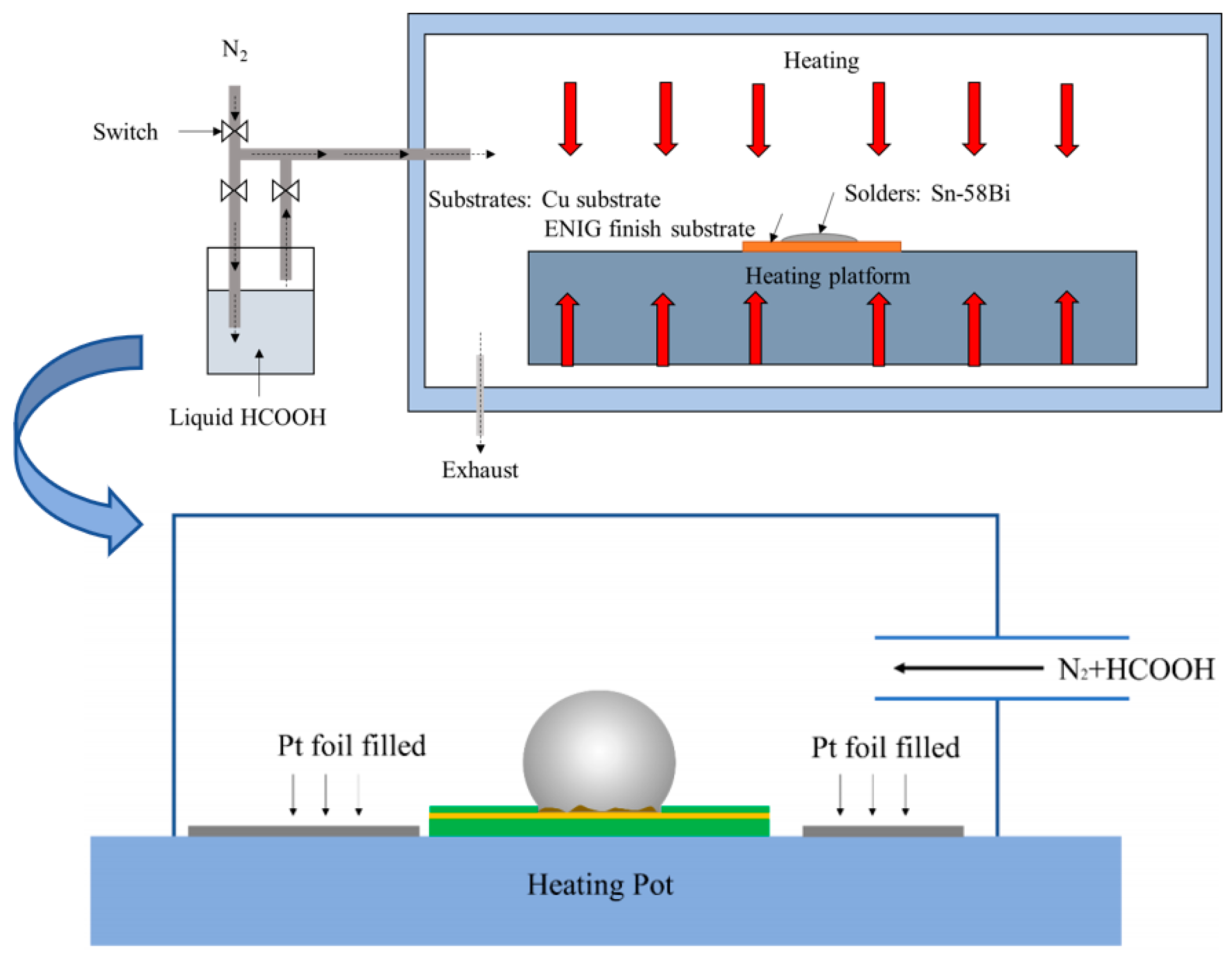
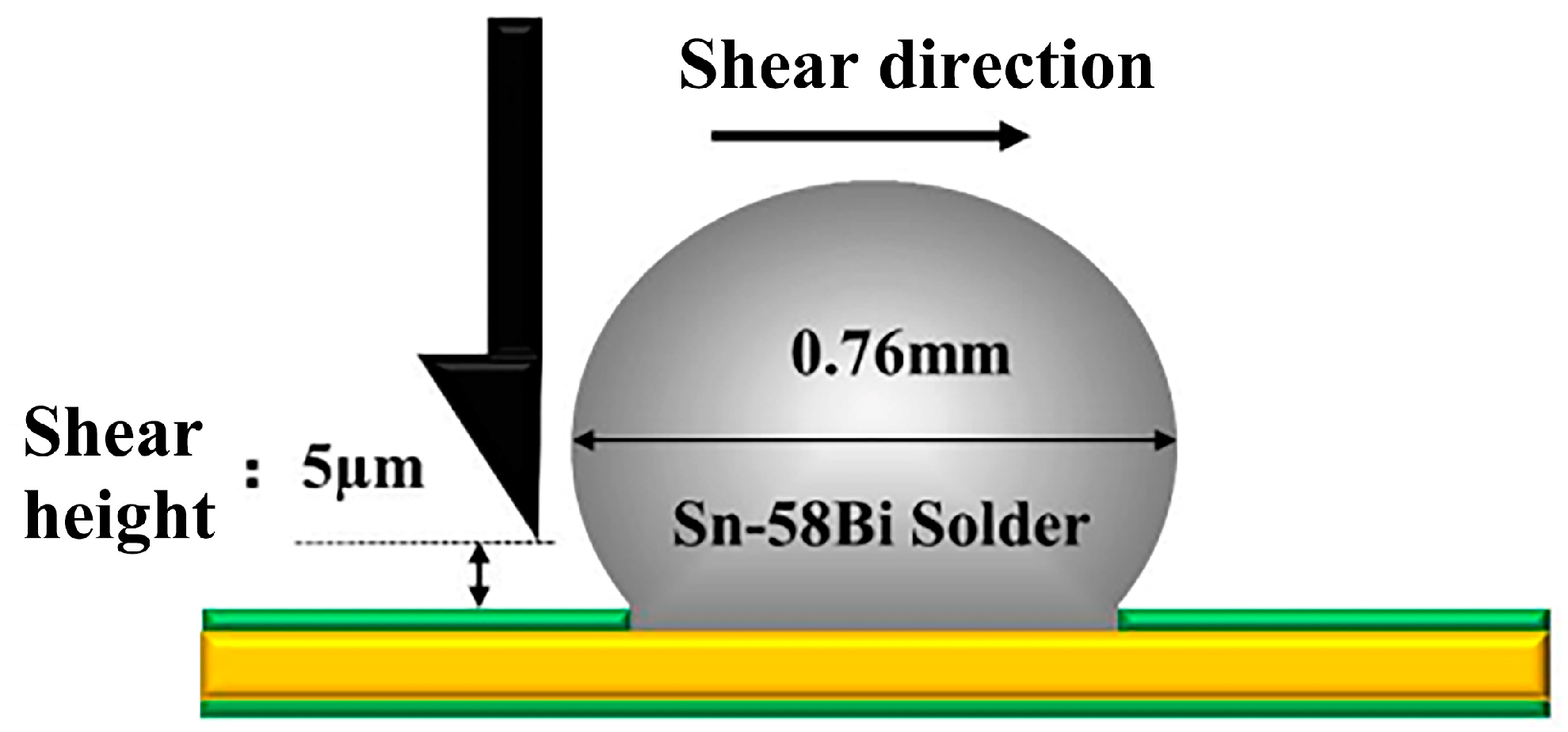

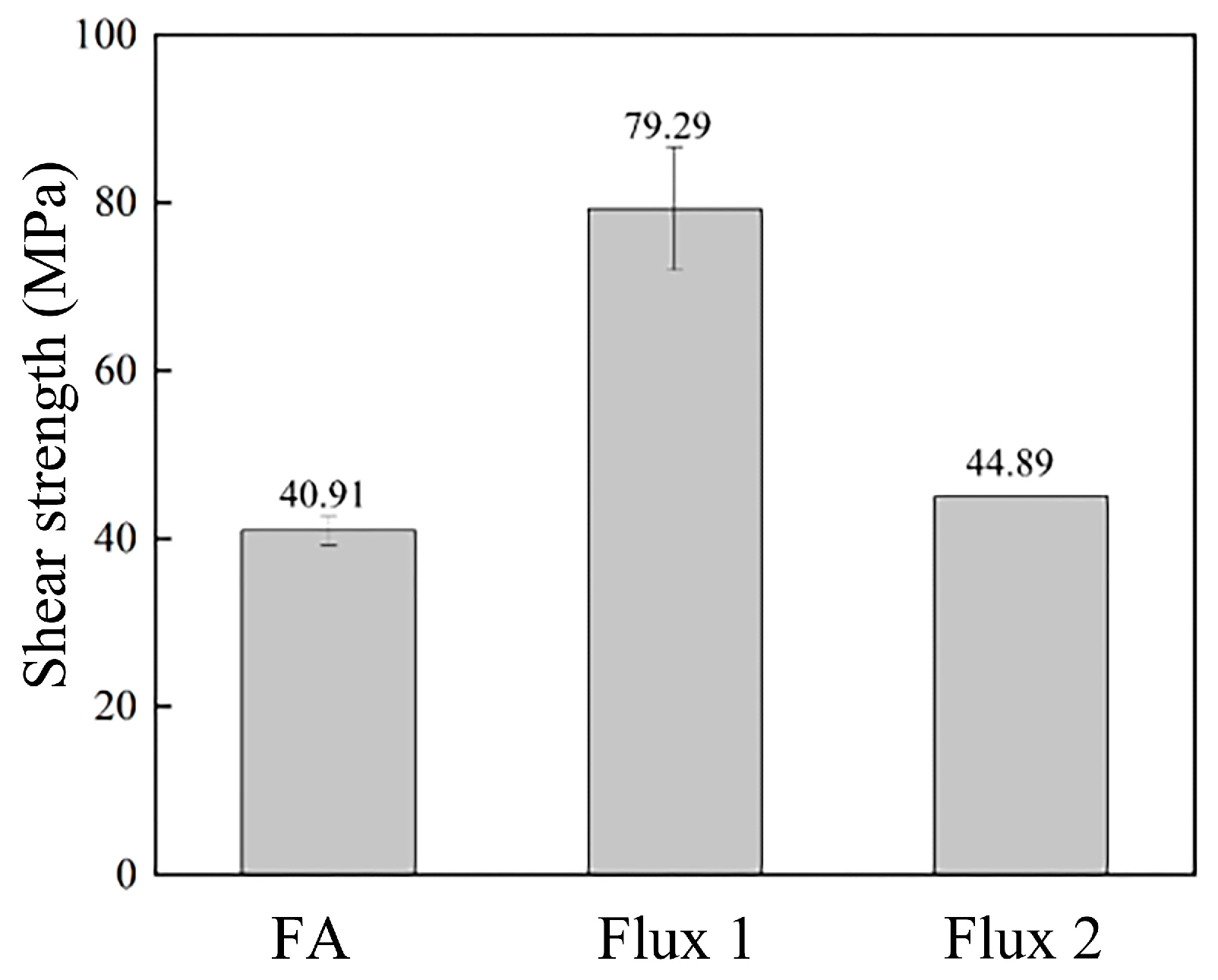

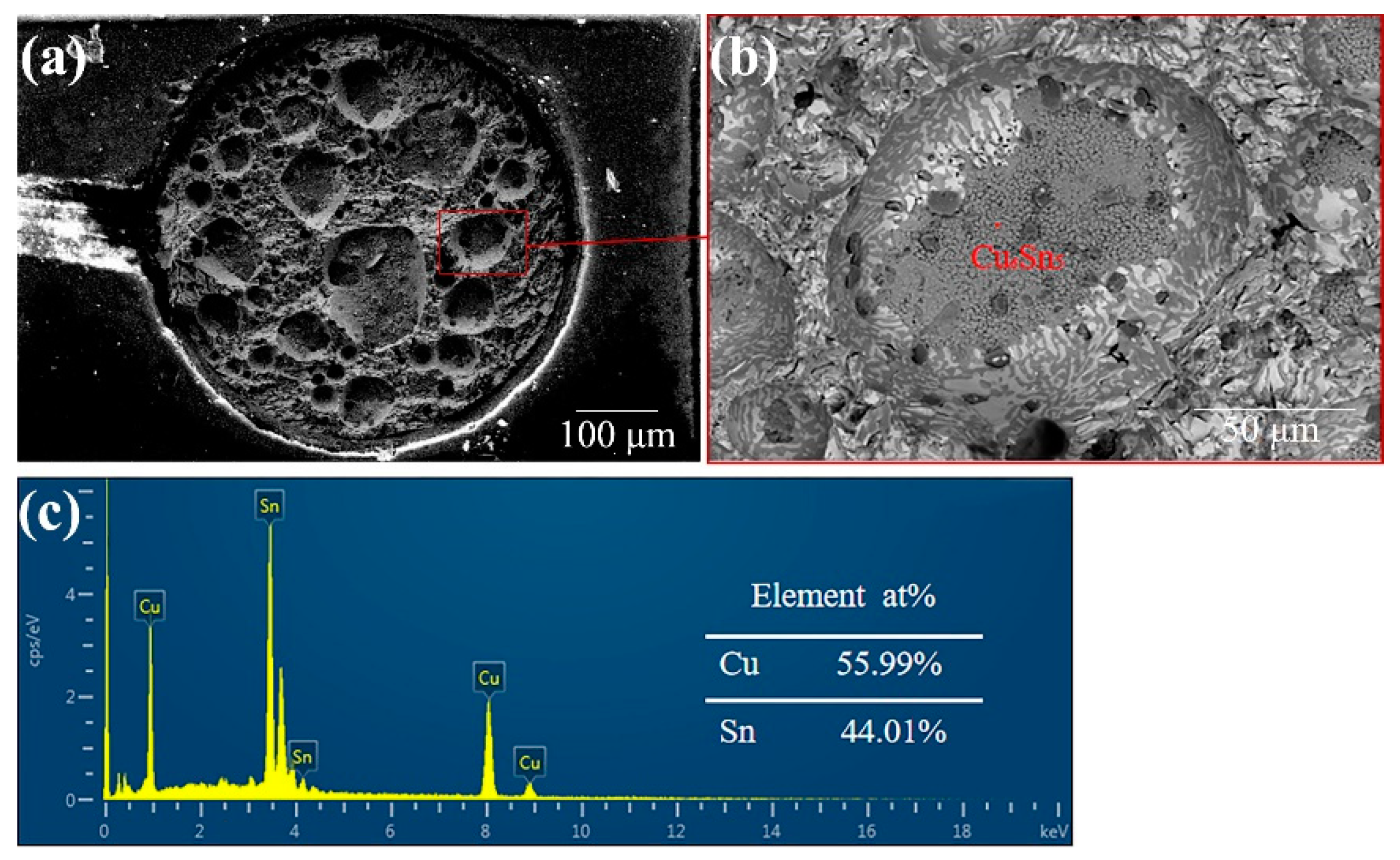

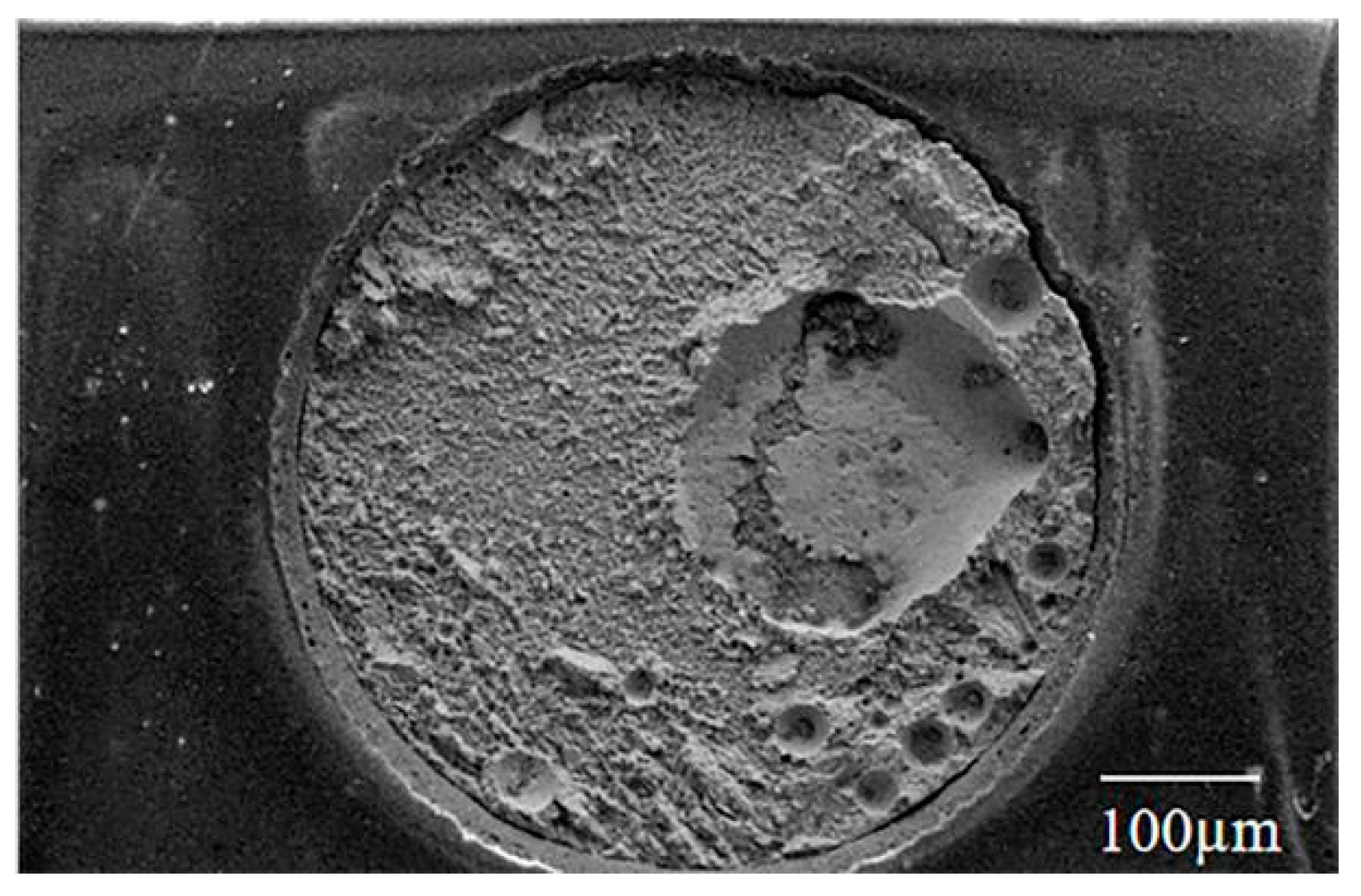
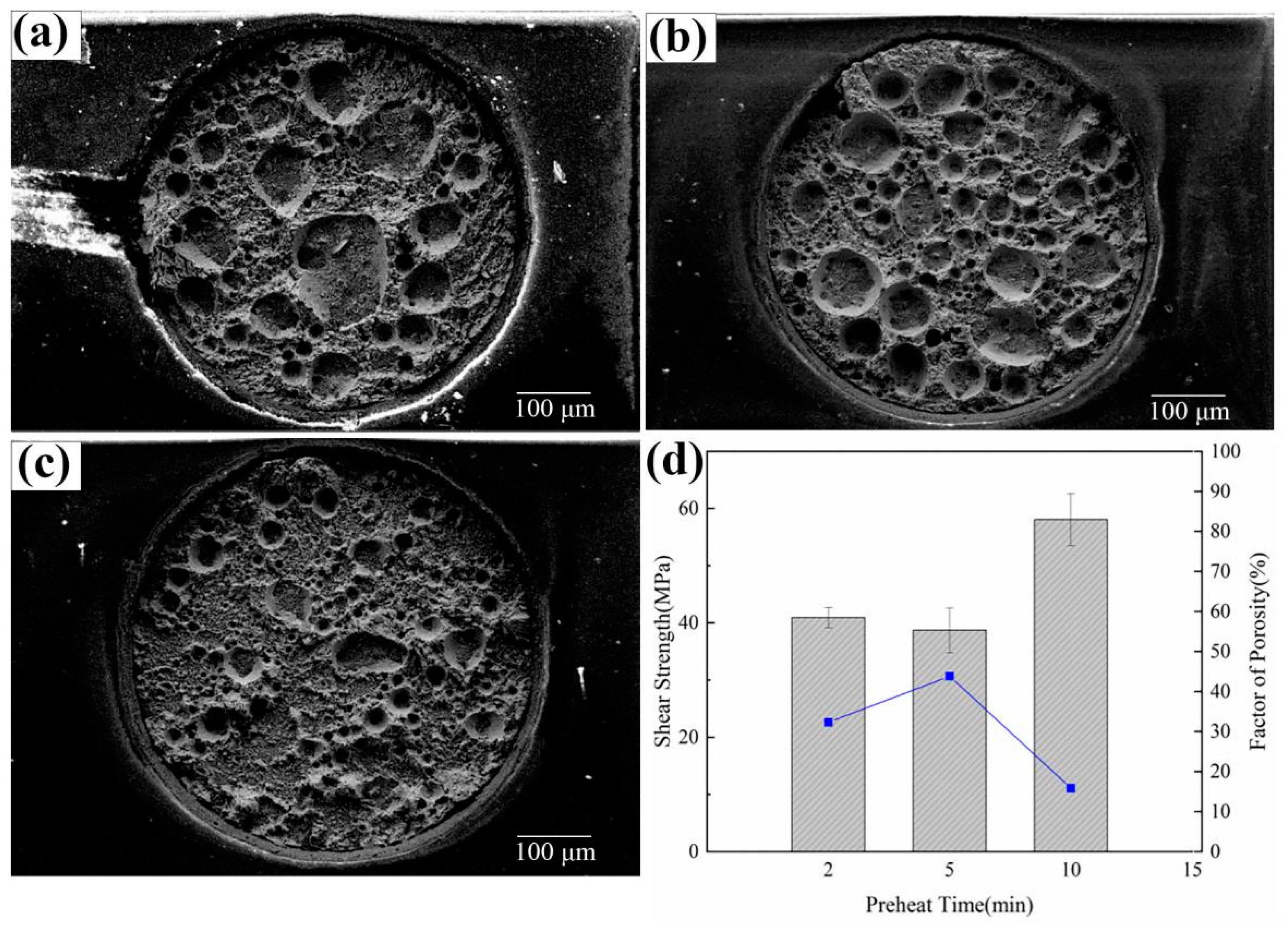
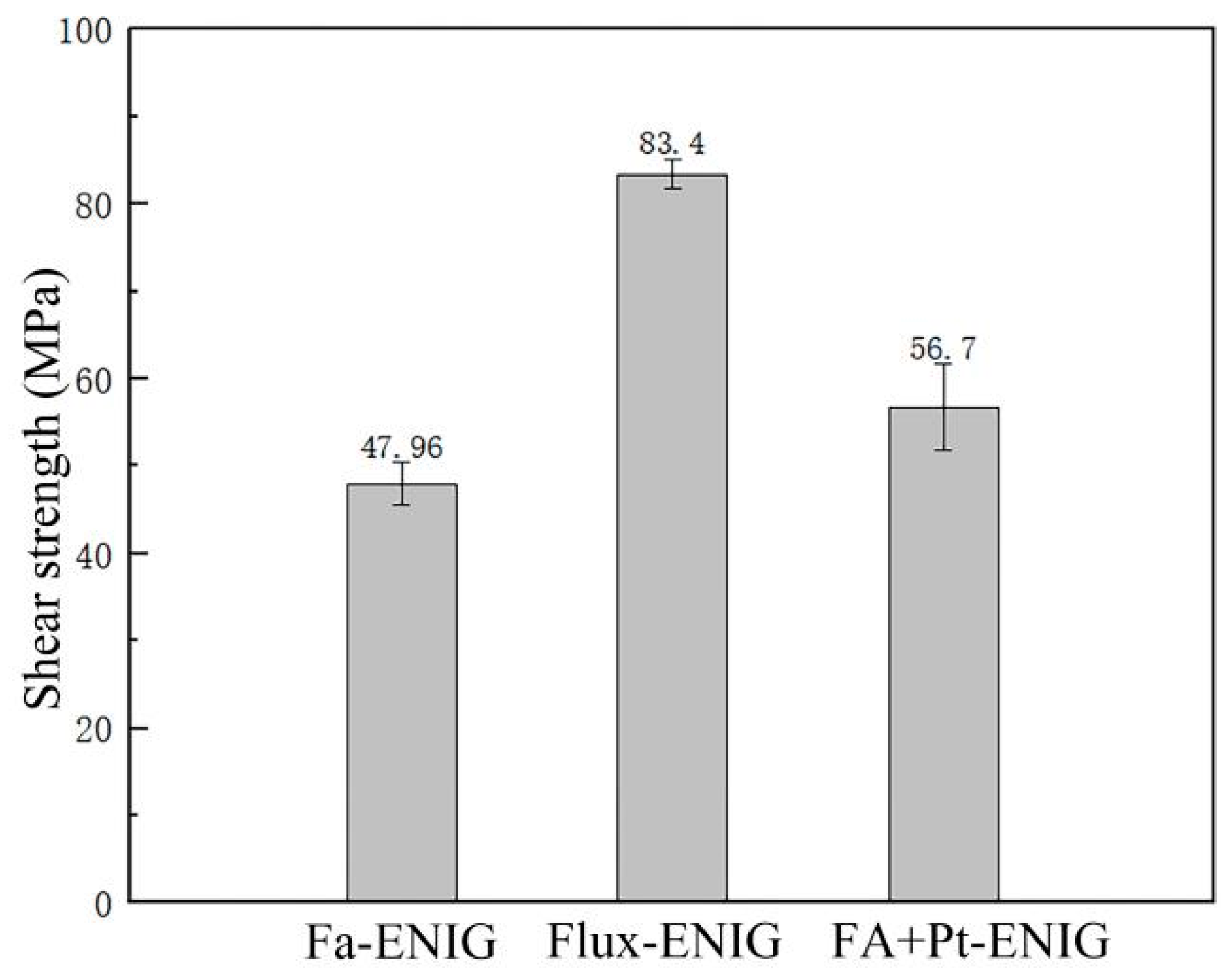


| Process | Percentage Porosity (%) |
|---|---|
| FA | 32.3 |
| Flux | 5.4 |
| Process | Shear Strength (MPa) |
|---|---|
| FA | 40.91 |
| FA + Pt | 39.19 |
| Process | Percentage Porosity (%) |
|---|---|
| FA | 32.3 |
| Pt catalytic | 23.5 |
| Process | 1 | 2 | 3 |
|---|---|---|---|
| Preheat temperature (°C) | 120 | 120 | 120 |
| Preheat time (minute) | 2 | 5 | 10 |
| Peak temperature (°C) | 200 | 200 | 200 |
| Peak time (minute) | 2 | 2 | 2 |
| Ramp rate (°C/s) | 1 | 1 | 1 |
Disclaimer/Publisher’s Note: The statements, opinions and data contained in all publications are solely those of the individual author(s) and contributor(s) and not of MDPI and/or the editor(s). MDPI and/or the editor(s) disclaim responsibility for any injury to people or property resulting from any ideas, methods, instructions or products referred to in the content. |
© 2024 by the authors. Licensee MDPI, Basel, Switzerland. This article is an open access article distributed under the terms and conditions of the Creative Commons Attribution (CC BY) license (https://creativecommons.org/licenses/by/4.0/).
Share and Cite
He, S.; Jiang, J.; Shen, Y.-A.; Mo, L.; Bi, Y.; Wu, J.; Guo, C. Improvement of Solder Joint Shear Strength under Formic Acid Atmosphere at A Low Temperature. Materials 2024, 17, 1055. https://doi.org/10.3390/ma17051055
He S, Jiang J, Shen Y-A, Mo L, Bi Y, Wu J, Guo C. Improvement of Solder Joint Shear Strength under Formic Acid Atmosphere at A Low Temperature. Materials. 2024; 17(5):1055. https://doi.org/10.3390/ma17051055
Chicago/Turabian StyleHe, Siliang, Jian Jiang, Yu-An Shen, Lanqing Mo, Yuhao Bi, Junke Wu, and Chan Guo. 2024. "Improvement of Solder Joint Shear Strength under Formic Acid Atmosphere at A Low Temperature" Materials 17, no. 5: 1055. https://doi.org/10.3390/ma17051055





